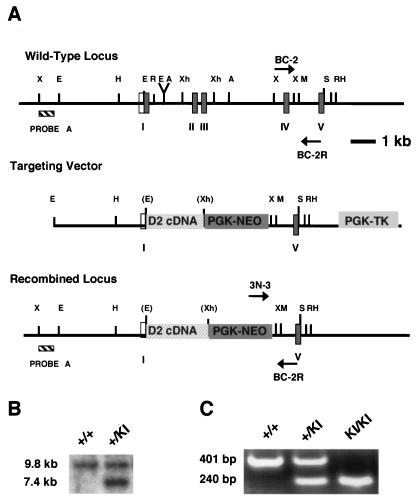FIG. 1.
Generation of cyclin D2→D1 mice. (A) Cyclin D2→D1 gene-targeting strategy. Shown are the wild-type cyclin D1 allele, the cyclin D2→D1 gene-targeting construct, and the predicted product of the homologous recombination at the cyclin D1 locus. Filled boxes denote coding exons of the cyclin D1 gene, which are numbered, and an open box represents a noncoding portion of the first exon. Probe A, used for Southern blot analyses of the recombinant ES cell clones, is also indicated. D2 cDNA, cyclin D2 cDNA; PGK-NEO, neomycin resistance gene driven by the phosphoglycerokinase (PGK) promoter; PGK-TK, thymidine kinase gene driven by the PGK promoter. Restriction enzyme abbreviations: X, XbaI; E, EagI; H, Hind III; R, EcoRI; A, Asp718; Xh, XhoI; M, Mfe I; S, SalI. (B) Southern blot analysis of ES cell clones. DNA was digested with XbaI endonuclease, resolved on a gel, blotted, and probed with the probe A depicted in panel A. The sizes of wild-type and recombinant alleles are shown. The genotypes of ES cell clones are indicated above the lanes. (C) PCR genotyping of animals. Tail DNA was PCR amplified as described in Materials and Methods and resolved on a 2% agarose gel. The sizes of bands deriving from wild-type and mutant alleles are indicated. The genotypes of animals are shown above the lanes.

